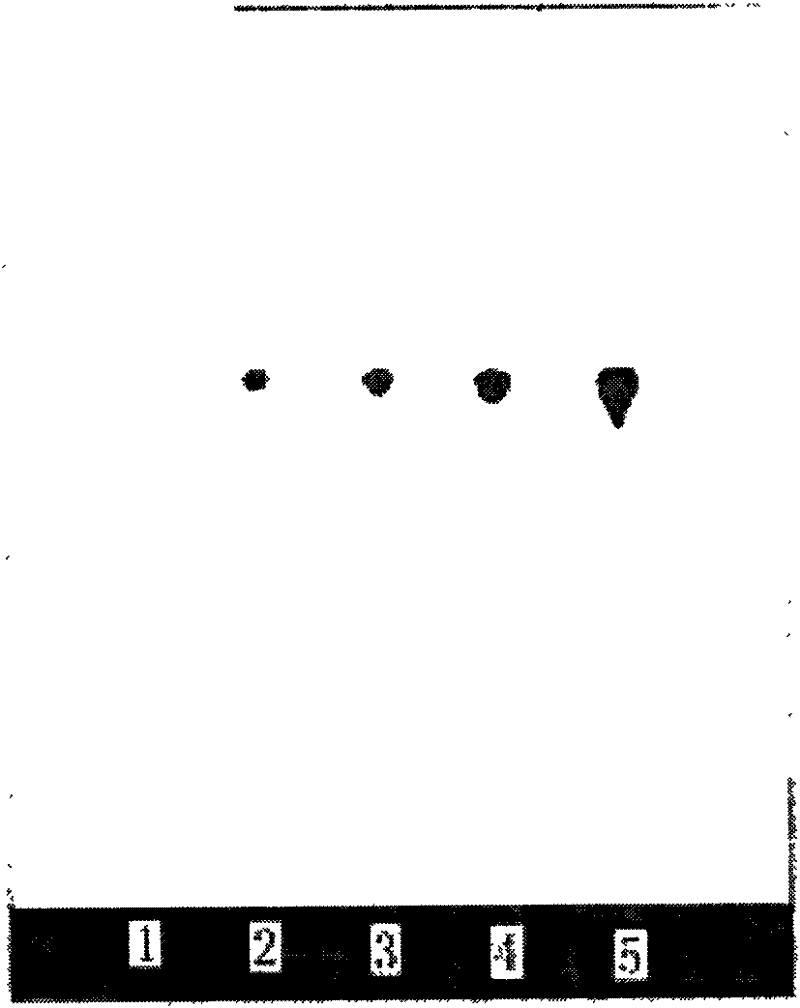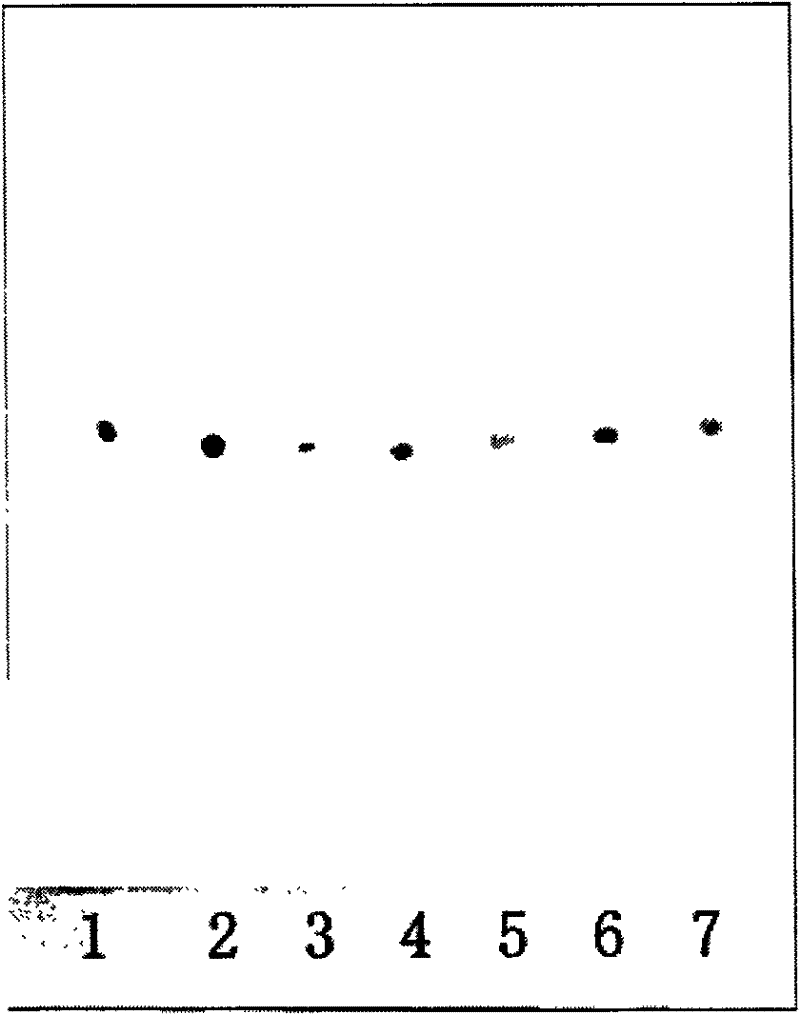Thin-layer chromatographic developer for detecting residual amount of tripolycyanamide and application of thin-layer chromatographic developer
A technology of thin-layer chromatography and melamine, which is applied in the field of thin-layer chromatography color reagents, can solve the problems of insufficient sensitivity and failure to meet the detection requirements of melamine, and achieve the effects of high detection sensitivity, clear spots and simple operation
- Summary
- Abstract
- Description
- Claims
- Application Information
AI Technical Summary
Problems solved by technology
Method used
Image
Examples
Embodiment 1
[0034] Embodiment 1 The specificity test of coloring agent of the present invention and detection method thereof
[0035] Preparation of the test solution: take by weighing 5.0 g of milk containing an appropriate amount of melamine (or a milk product equivalent to 5.0 g of milk), put it in a stoppered Erlenmeyer flask, add 10 mL of 1% trichloroacetic acid solution, and shake while adding , then add 1mL of 2.2% lead acetate solution and 4mL of chloroform, shake fully for 2min, transfer to a centrifuge tube, and set at 3000r·min -1 Centrifuge for 2 minutes, take the supernatant, put it in the original Erlenmeyer flask, add 10 mL of 1% trichloroacetic acid solution, shake and mix for 2 minutes, transfer the solution to a centrifuge tube, wash the cone with a small amount of 1% trichloroacetic acid solution Shaped bottle, the washing liquid was combined into a centrifuge tube, and the -1 Centrifuge for 2 minutes, and take the supernatant for later use. Transfer the supernatant t...
Embodiment 2
[0039] Embodiment 2 The detection limit test of coloring agent of the present invention and detection method thereof
[0040] Draw the same reference substance solution (0.05mg·mL) of the above-mentioned Example 1 respectively -1 )5, 10μL and reference solution (0.5mg·mL -1 ) 2, 4, and 10 μL were respectively spotted on the same prefabricated silica gel G thin-layer plate, according to the operation of Example 1 "Inspection Method", with acetone-chloroform-ammonia (7:0.5:2, V / V / V) as Developing agent, saturated for 5 minutes, developed, taken out, dried in the air, heated at 105°C for 10 minutes, taken out, immersed in 1% ethanol solution of p-dimethylaminobenzaldehyde hydrochloride (containing 0.3% hydrochloric acid) while hot for 5 to 15 seconds, taken out, Immediately dry it with hot air, and inspect it under ultraviolet light (365nm).
[0041] The result is as figure 2 shown. The spotting amounts of Nos. 1 to 5 in the figure are 0.25, 0.5, 1.0, 2.0 and 5.0 μg in seque...
Embodiment 3
[0042] Embodiment 3 The recovery rate test of colorant of the present invention and detection method thereof
[0043] Weigh 5.0 g of 3 parts of milk without melamine, add different amounts of melamine reference solution respectively, so that the melamine content is 2, 5, 10 mg·kg -1 , and the serial numbers are the test solution ①, the test solution ②, and the test solution ③. Sample preparation in the same manner as in Example 1 "Preparation of the test solution", the concentrations of melamine in the test solution ①, ② and ③ were 0.02, 0.05, 0.10 mg·mL respectively -1 . Draw the reference substance solution (0.5mg·mL -1 ) 2, 4 μL and test solution ① 50, 100 μL, test solution ② 25, 50 μL, test solution ③ 25 μL, respectively spot on the same prefabricated silica gel G thin-layer plate, and operate in the same way as in Example 1 "Inspection method".
[0044] The result is as image 3 As shown, No. 1 to No. 2 in the figure are reference substance solutions, and the sample v...
PUM
 Login to View More
Login to View More Abstract
Description
Claims
Application Information
 Login to View More
Login to View More - R&D
- Intellectual Property
- Life Sciences
- Materials
- Tech Scout
- Unparalleled Data Quality
- Higher Quality Content
- 60% Fewer Hallucinations
Browse by: Latest US Patents, China's latest patents, Technical Efficacy Thesaurus, Application Domain, Technology Topic, Popular Technical Reports.
© 2025 PatSnap. All rights reserved.Legal|Privacy policy|Modern Slavery Act Transparency Statement|Sitemap|About US| Contact US: help@patsnap.com



